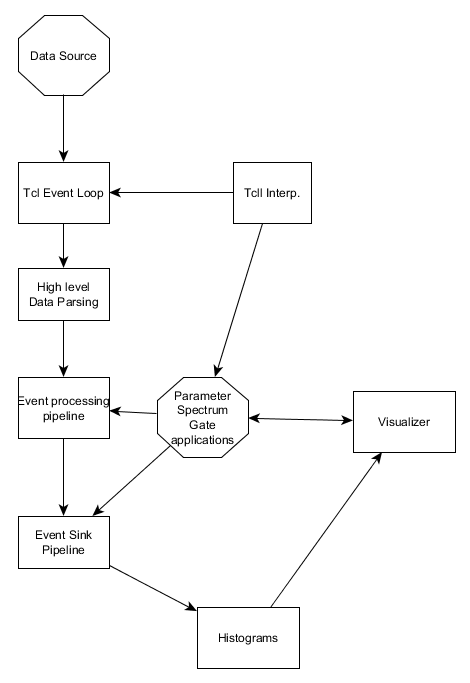Chapter 2. The SpecTcl processing model.
This chapter describes the SpecTcl processing model. In order to effectively write SpecTcl based software it is important to have some understanding of how SpecTcl organizes its computing. The intent of this chapter is to provide an overview of this processing model. Each of the remaining chapters in this book will then zoom in on one section of that model and describe how to write software that extends or lives inside of that section.
The figure below graphically shows the major components of SpecTcl and their main interactions.
The core of SpecTcl is a command interpreter that is an extended version of the Tcl/Tk scripting language (http://www.tcl.tk). Tcl is a general purpose programming language with a very simple syntax. You can learn most of what you need about Tcl in under an hour. The Tk toolkit bolts on to Tcl providing a mechanism for Tcl scripts to create rich graphical user interfaces.
SpecTcl extents the Tcl interpreter. It adds commands to the interpreter that provide the ability to create and manipulate the objects SpecTcl needs. The most prominent of these objects are parameters, spectra, gates and gate applications. Parameters, spectra and gates are held in dictionaries indexed by their names. Gate applications are stored with their spectra.
Tcl/Tk's processing model provides an event loop. An event loop reacts to events and dispatches them to appropriate handlers. SpecTcl's Tcl extensions establish a source of events. When the data source has data avaialable, the event loop dispatches it to a processing pipeline.
The first stage of event processing knows about the high level format of the data. This is used to unpack blocks of data into units that consist of, among other things events. This is represented by the diagram's High level parsing box. In most cases you will not need to provide or modify that code. That code only needs to be touched if you are adapting SpecTcl to data from a new data acquisition system not supported by SpecTcl.
The high data parsing stage locates blocks of events (a block may be a single event long as it is for ring buffer data). Events from this block are passed one by one to the event processing pipeline.
The event processing pipeline is the code you will normally have to write. It takes a raw event and extracts meaningful parameters from it. The format of a raw event and the definition of meaningful parameter are both experiment specific.
The event processing pipeline consists of an arbitrary number of stages. Each stage has access to the raw event and to the parameters that have been unpacked from it by the prior stages. Careful organization of the functionality of your event processors can be key both to allowing your detector system to be easily reconfigured and to layering the extraction of computed parameters on top of raw parameters in a meaningful and organized way.
The parameters produced by the event processing pipeline are then passed to the event sink pipeline. The main component of that is the histogramming kernel. It uses the parameters, parameter definitions, spectrum definitions, gate applications and relevant gate definitions to determine which histograms will be incremented and where.
At this point, the only other elements that live in the event sink pipeline are filters. Filters produce a reduced data set by outputing some set of parameters for events that satisfy a gate. It is very unusual for application specific code to need to add elements to the event sink pipeline, though that is possible.
Histograms are stored by SpecTcl as arrays of data with descriptive metadata. SpecTcl has no built in visualization component. It can store spectrum bulk data in a shared memory region and supports a few well defined communications mechanisms that allow external displayers to let you visualize and interact with the data. The two visualizers that are currently supported are Xamine and Spectra. Xamine is an X-11/Motif application, while spectra is based on Root (http://root.cern.ch).
We won't say anything about Spectra in this document, however Xamine provides hooks to allow your code to interact with it and the data it displays. We'll describe how to take advantage of those hooks.
